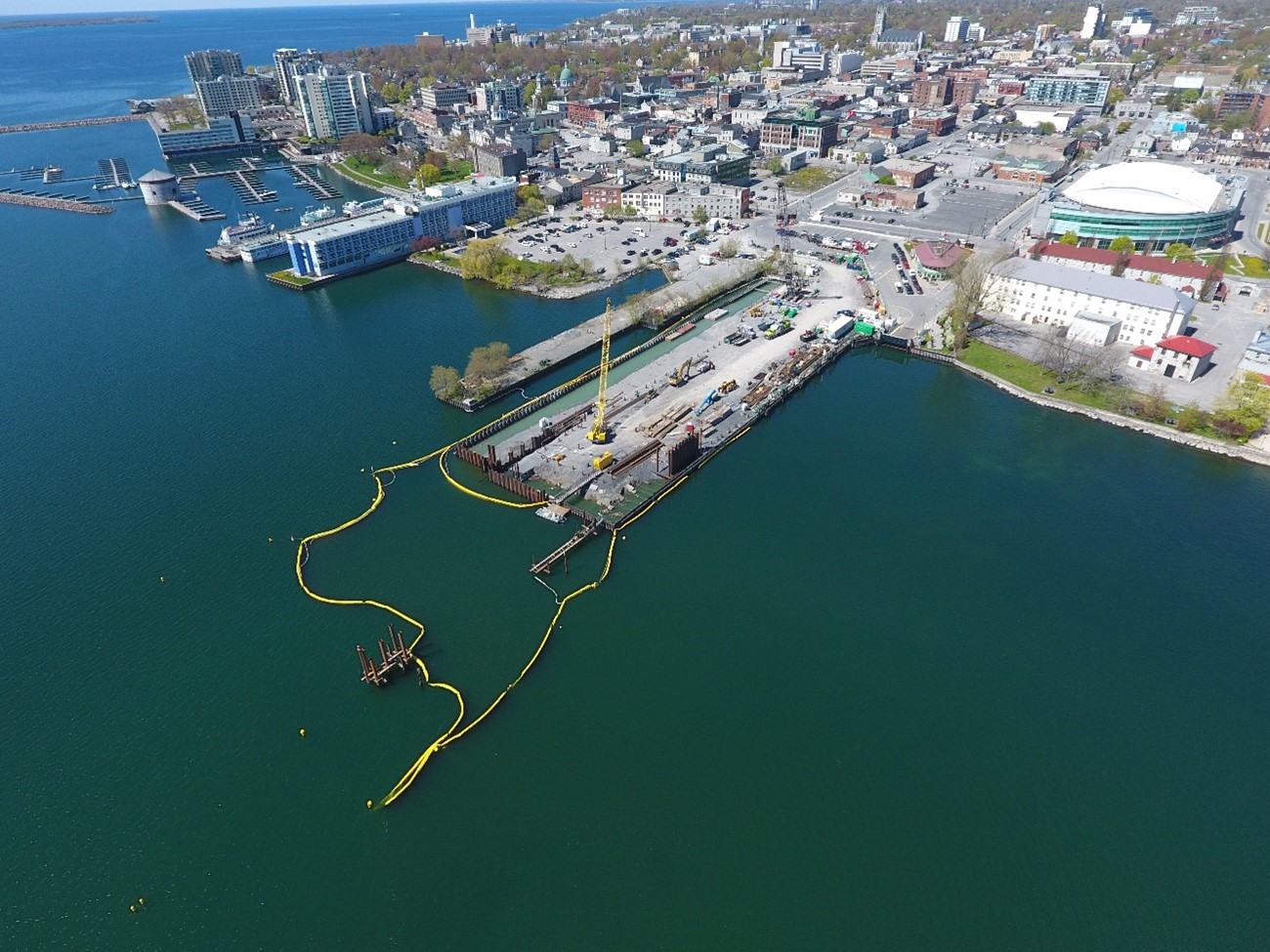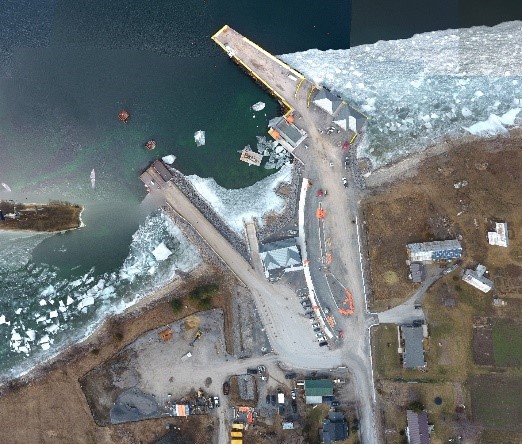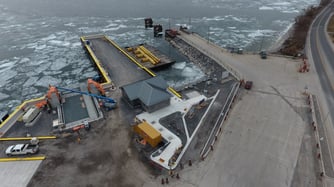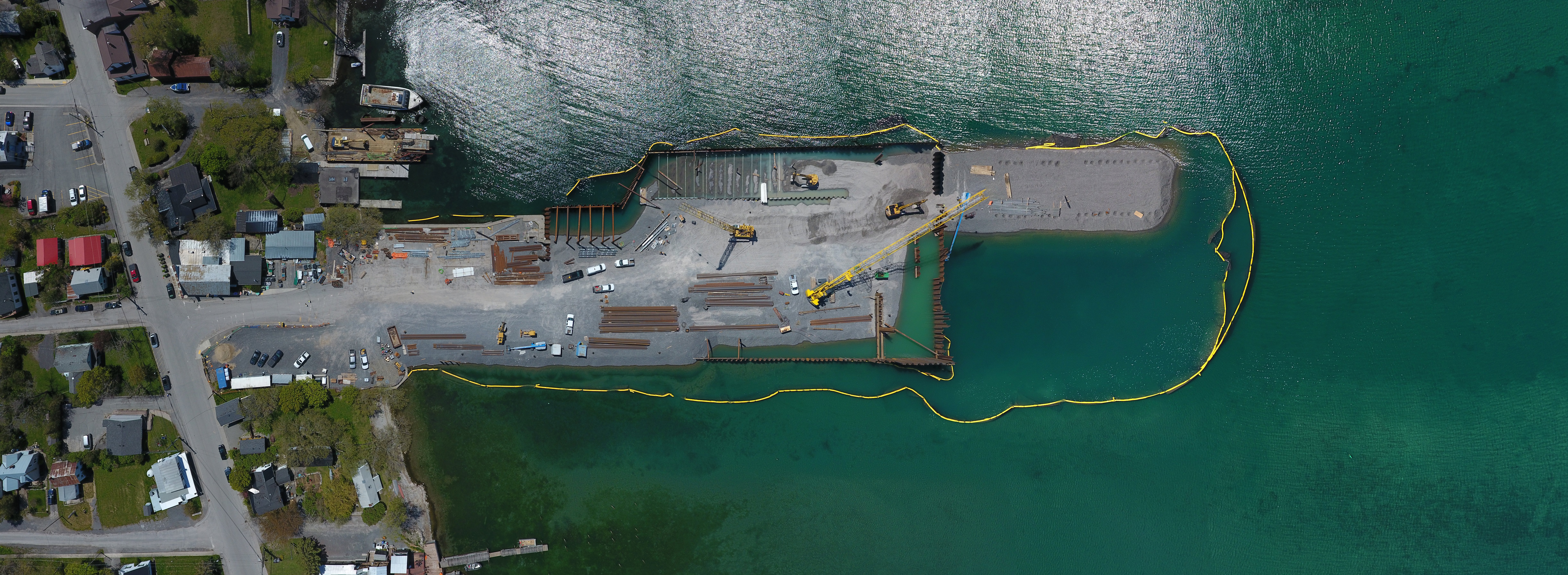Designing the Infrastructure for What Could be the First Electrified Ferries in North America
Access to Amherst Island and Wolfe Island in Eastern Ontario is being improved with reconstructed ferry docks. Residents and visitors will benefit from expanded service and a more efficient and sustainable transportation network.
The upgraded ferry docks will dramatically increase accessibility to and from the islands and increase both the capacity of service per boat and the potential to increase the frequency of the trips. With these two projects, Ontario expects to reduce its greenhouse gas emissions by the equivalent of 446 million kilograms of carbon dioxide during the ferries’ 60-year lifespans.

The two existing ferry facilities were evaluated for upgrades under traditional conditions. During the process, an opportunity arose to change to electrified ferries and design the ferry docks to include the supporting infrastructure.
.png?width=669&name=Ferries%20Infographic%20(2).png)
The Need for a New Solution
The previous ferries were overcapacity, resulting in long wait times. It was determined that upgrades were required to provide a growing population with more reliable and efficient service. The previous Amherst Island ferry was side-loading and inconvenient for large vehicles. The new vessels will be end-loading ferries that allow vehicles to drive on and off facing the same direction, reducing loading and unloading times.
Three out of four of the original docking areas did not provide any protective shelter and had limited amenities for passengers. The redeveloped terminals provide an enhanced experience for users, including newly paved marshalling areas to accommodate waiting vehicles on the site so that they don’t spill out onto the adjacent roadways. They also include new sidewalks and facilities such as restrooms, waiting areas, bike racks and staff offices.
Both projects will see an increase in the number of passengers and vehicles onboard each ferry which will help the local economies on the islands through tourism. The ferries bring extra capacity and will make crossings faster as well as greener for the one million passengers and 500,000 vehicles which travel annually between Wolfe Island and Kingston, and the 270,000 passengers and 130,000 vehicles which travel to and from Amherst Island each year.
The Amherst Island ferry dock serves both tourists and island residents primarily from the Town of Stella. Currently, the project is in a race with a Toronto to run the first fully electric ferries in North America. Both are expected to be operational later this year. |
 |
Wolfe Island, off the shore of Kingston, ON is a small village of 1,500 people with some small businesses. It is a popular destination for visitors during the summer. Once complete, the reduced wait times and increased ferry capacity will encourage even more visitors to the island. |
|
Design Flexibility to Accommodate Ferry Electrification
Damen Shipyards is the designer and builder of the new electric ferries that are being developed in parallel with the ferry dock designs. The new ferries were only in the initial concept stage when the dock design began. As lead design engineers, Morrison Hershfield facilitated the integration of ferry design and new docking facilities to ensure the systems would be operational when the new ferries arrived from Europe. Collaboration was required to provide infrastructure solutions that would accommodate adjustments to the ferry design. In addition, the new charging stations developed for the ferries were the first of their kind, and their ultimate size and weight required adjustments to the dock designs.
Fighting Climate Change with Green Ferries Ontario Power Generation was keen to get involved in the project and introduced another aspect to the electrification – the use of the battery storage system to offset the demand from the grid during peak hours. The size of battery storage was increased to maximize energy taken during non-peak hours and conserve electricity during peak hours. This process, known as global load displacement, lowers operating energy costs and helps mitigate impacts of rising rates by offsetting energy costs. It also allows for enhanced energy resiliency during outages. Conserving electricity during peak hours prevents the grid from becoming overwhelmed with increased energy loads and contributes to the stability of the grid in Ontario. Over the course of the project, the initial design of the ferry docks had to be changed to accommodate for the electrification of the ferries, and then redesigned again to accommodate for the load displacement.
Ontario Power Generation was keen to get involved in the project and introduced another aspect to the electrification – the use of the battery storage system to offset the demand from the grid during peak hours. The size of battery storage was increased to maximize energy taken during non-peak hours and conserve electricity during peak hours. This process, known as global load displacement, lowers operating energy costs and helps mitigate impacts of rising rates by offsetting energy costs. It also allows for enhanced energy resiliency during outages. Conserving electricity during peak hours prevents the grid from becoming overwhelmed with increased energy loads and contributes to the stability of the grid in Ontario. Over the course of the project, the initial design of the ferry docks had to be changed to accommodate for the electrification of the ferries, and then redesigned again to accommodate for the load displacement.
The Finish Line
The dynamic nature of the project required a significant amount of flexibility on the part of the design and construction teams. A close working relationship with all parties yielded new ferries and ferry docks, infrastructure that will improve the local economy, and transportation enhanced in a responsible and sustainable way.
As for the winner of the title for the first electrified ferries in service in North America? We will have to wait to see whether Amherst or Toronto will claim that title.
Posts by Topic
Topics
- 5G (1)
- ACEC (3)
- Active Transportation (5)
- AFP/P3 (6)
- Alberta (5)
- Anniversary (1)
- approvals (1)
- Architect (2)
- Atlanta (2)
- Awards (62)
- Biophysical Sciences (1)
- Board of Directors (1)
- Bridge Rehabilitation (3)
- Building and Facilities Engineering (2)
- Building Energy (25)
- Building Envelope (48)
- Building Science (65)
- Calgary (2)
- Canada 150 (1)
- Canstruction (2)
- Capabilities (1)
- Carbon emissions (2)
- Carbon Pathfinder Tool (1)
- Carson Awards (5)
- Charity (13)
- Climate Adaption (7)
- climate change (7)
- Code and Life Safety (8)
- Commercial Buildings (4)
- Commissioning (11)
- Construction (2)
- Construction Administration (5)
- Consulting Engineering (1)
- Critical Facilities (33)
- CSR (24)
- Culture (5)
- Dallas (1)
- Data Center (22)
- Data Center Commissioning (9)
- Data Center Design (12)
- design (9)
- Design Build (1)
- DSSP (1)
- edgecomputing (1)
- edgetechnologies (1)
- Edmonton (4)
- Electrical (24)
- Electrical engineering (8)
- Energy (8)
- Engineers Canada (5)
- Environmental (36)
- Environmental Compensation (1)
- Environmental Impact Assessment (3)
- environmental planner (3)
- Environmental Planning (5)
- ETFE (1)
- Event (12)
- Existing Buildings (6)
- Facade Engineering (4)
- Ferry Docks (2)
- FIDIC (3)
- fisheries biologist (1)
- Flood Mapping (1)
- Florida (1)
- Forensic Investigation (1)
- Fundraising (11)
- garage (2)
- Gender Diversity (8)
- Gender Intelligence (3)
- Geometric Design (2)
- Government (14)
- Hospitality (1)
- Houston (4)
- Hydro (2)
- India (1)
- industrial (4)
- Infrastructure (28)
- Innovation (1)
- interchange (1)
- IWD (2)
- IWD2021 (1)
- Land Development (8)
- Landfill (4)
- Manitoba (1)
- MCF (3)
- Mechanical (21)
- Mechanical Engineering (1)
- MEP (1)
- mission critical (10)
- Moncton (1)
- Motivational MH'er (1)
- Multi-Use Pathways (1)
- Municipal Infrastructure (5)
- municipal solid waste (2)
- MUP (1)
- New Brunswick (1)
- New Hire (17)
- New Role (3)
- Newsroom (121)
- northern communities (2)
- NVTC (2)
- ontario (1)
- Operations Consulting (8)
- Ottawa (2)
- Panel (3)
- People (124)
- Project Management (6)
- QAP (1)
- Rail (1)
- Reconstruction (1)
- regulatory (1)
- Renewable Energy (2)
- resiliency (3)
- Risk Management (1)
- Roads and Highways (3)
- Salt Lake City (1)
- Seattle (1)
- Security (4)
- Social Responsibility (30)
- Solid Waste (11)
- solid waste management (5)
- St Johns (2)
- Stantec (1)
- Structural (14)
- Sustainability (23)
- Telecom (9)
- Texas (1)
- Toronto (13)
- towers (1)
- Traffic Assessment (2)
- Transfer Station (1)
- Transit (13)
- Transit Consultant (3)
- Transit Infrastructure (3)
- Transit Planning (2)
- Transportation (30)
- Transportation Engineering (8)
- transportation structures (2)
- TTC (1)
- Vancouver (6)
- Virginia (2)
- Washington DC (3)
- Waste to Energy (2)
- Water & Wastewater (8)
- Water Resources (3)
- wellfield (1)
- wellness challenge (1)
- Whistler (1)
- Whitehorse (1)
- Wireless (2)
- Women in Engineering (5)
- Yukon (5)
